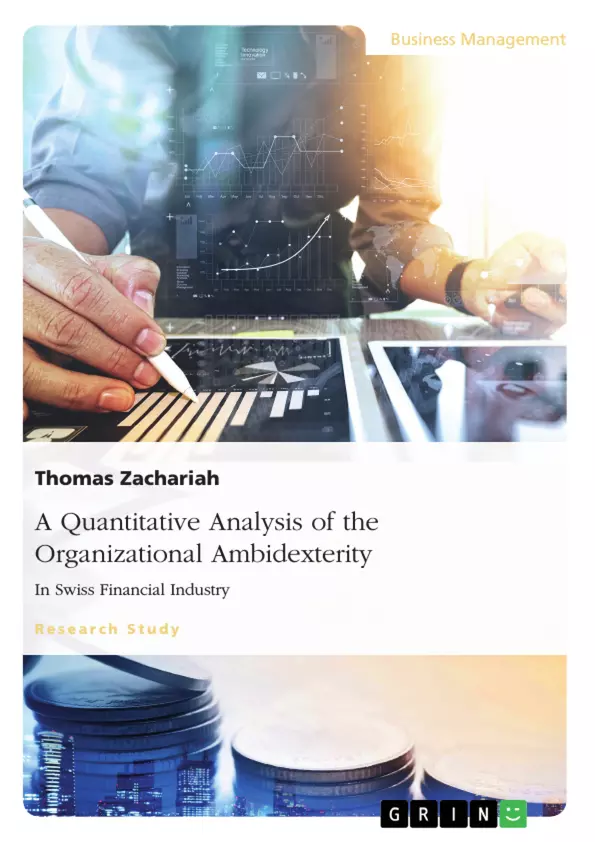In the context of the contemporary global business environment, the challenges and the level of competition has increased significantly. The organizational entities within the Swiss financial institutes have been negatively impacted by these challenging factors which have emerged due to the global recession. The purpose of this research is to analyze the level of the ambidexterity present within the Swiss financial industry. The overall research question guiding this study is: What are the factors predicting organizational ambidexterity in the Swiss Financial Industry? This quantitative correlation study utilizes a web-based survey to assess the level of organizational ambidexterity in the Swiss Financial Industry. To address the research question, three empirical models were constructed using partial least squares structural equation modeling (PLS-SEM). The models predicted the levels of organizational ambidexterity in the Swiss financial industry (divided into exploratory innovation and exploitative innovation) using nine independent predictors representing holistic business environment factors highlighting management and productivity issues within the Swiss market. These factors included financial stability, adaptability, leadership, exploration, innovation, exploitation, communication, connectedness, and formalization. The empirical models constructed in this study support the concept of a good fit by predicting that a balance between multiple internal and external market attributes lead to organizational ambidexterity. The results yield that apart from communication the remaining factors defined are good predictors of organizational ambidexterity in Swiss Financial Industry.
Inhaltsverzeichnis (Table of Contents)
- Abstract
- List of Figures
- List of Tables
- List of Abbreviations
- List of Appendices
- Chapter 1: Overview
- Problem Statement
- Purpose of Research
- Significance of the Study
- Research Design
- Research Questions
- Assumptions and Limitations
- Operational Definitions
- Summary
- Chapter 2: Literature Review
- Organizational Ambidexterity
- The Past: The Origins of Organizational Ambidexterity
- The Present: Evidence Regarding Organizational Ambidexterity
- Achieving Organizational Ambidexterity
- Innovation and Organizational Ambidexterity
- Theoretical Perspective
- Synthesis of Factors Affecting Organizational Ambidexterity
- Chapter 3: Research Methodology
- Purpose of Research
- Research Design
- Research Questions and Hypotheses
- Operationalization of Variables
- Population and Sample Strategy
- Research Instrument
- Validation and Reliability of the Instrument
- Data Collection Procedures
- Ethical Considerations
- Data Analyses
- Demographics of the Participants
- Chapter 4: Analysis and Presentation of Results
- Research Questions and Hypotheses
- Demographic Statistics
- Details of Analysis and Results
- Summary of Results
Zielsetzung und Themenschwerpunkte (Objectives and Key Themes)
This research aims to analyze the level of organizational ambidexterity present within the Swiss financial industry. The main research question guiding this study is: What are the factors predicting organizational ambidexterity in the Swiss Financial Industry?
- Organizational ambidexterity in the Swiss financial industry
- Factors predicting organizational ambidexterity
- Empirical models using partial least squares structural equation modeling (PLS-SEM)
- Holistic business environment factors impacting organizational ambidexterity
- The relationship between internal and external market attributes and organizational ambidexterity
Zusammenfassung der Kapitel (Chapter Summaries)
Chapter 1: Overview provides an introduction to the research, outlining the problem statement, purpose, significance, research design, questions, assumptions, limitations, and operational definitions. The chapter concludes with a summary of the key points.
Chapter 2: Literature Review explores the concept of organizational ambidexterity, tracing its origins and examining current evidence. It discusses the factors contributing to organizational ambidexterity and its relationship with innovation. The chapter also presents a theoretical perspective and synthesizes factors affecting organizational ambidexterity.
Chapter 3: Research Methodology details the research design, questions, hypotheses, and operationalization of variables. It describes the population and sample strategy, research instrument, validation and reliability procedures, data collection methods, ethical considerations, and data analysis techniques. The chapter concludes with information on the demographics of the participants.
Chapter 4: Analysis and Presentation of Results presents the findings of the research, including demographic statistics, detailed analysis and results, and a summary of the key findings.
Schlüsselwörter (Keywords)
This research focuses on organizational ambidexterity, exploration, and exploitation in the Swiss financial industry. It uses a quantitative approach and employs partial least squares structural equation modeling (PLS-SEM) to examine the relationship between various factors, including financial stability, adaptability, leadership, exploration, innovation, exploitation, communication, connectedness, and formalization, and organizational ambidexterity.
- Quote paper
- Thomas Zachariah (Author), 2015, A Quantitative Analysis of the Organizational Ambidexterity in Swiss Financial Industry, Munich, GRIN Verlag, https://www.grin.com/document/353605



